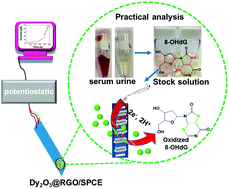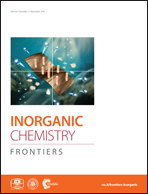Determination of 8-hydroxy-2′-deoxyguanosine oxidative stress biomarker using dysprosium oxide nanoparticles@reduced graphene oxide†
Abstract
8-Hydroxy-2′-deoxyguanosine (8-OHdG) is a risk factor; it plays a crucial role in inducing oxidative stress involved in the physiological processes and it is a biomarker in the response to human disease and injury. Therefore, the development of a robust, low-cost, and portable analytical tool for quantification of 8-hydroxy-2′-deoxyguanosine in human blood and urine samples is required. It is essential to diagnose oxidative stress-related diseases in human body. For this purpose, herein, we report an electrochemical sensor based on Dy2O3 nanoparticle-decorated reduced graphene oxide nanocomposite (Dy2O3 NPs@RGO). A microwave-assisted synthetic route was adopted to prepare Dy2O3 NPs@RGO. Subsequently, its morphological, elemental, and crystal structure properties were analyzed. Electrochemical and interfacial properties were examined to ensure the material's suitability in electrocatalytic sensing. Dy2O3 NPs@RGO-affixed conventional screen-printed electrode (SPCE) was found to exhibit tremendous electrocatalytic capability toward 8-OHdG oxidation. A sensitive and reproducible sensor for the amperometric detection of 8-OHdG was fabricated, which could detect concentrations as low as 1.02 nM. The method worked well even in real samples (human urine and blood serum), and the results were validated by the HPLC method, indicating the reliability of the proposed method in clinical analysis.



 Please wait while we load your content...
Please wait while we load your content...